Daniel MacCarthy (Glas) Collection
Daniel MacCarthy (Glas) Collection (Ref. PR70)
View descriptive list of the Daniel MacCarthy (Glas) Collection.
The archive of writer and historian Daniel MacCarthy Glas (died 1884) was donated by Susan MacCarthy and Don MacCarthy, and families, of Salem, Oregon, USA.

View descriptive list of the Daniel MacCarthy (Glas) Collection.
Daniel was born to a wealthy Irish Catholic merchant family in London in 1807. His grandfather had emigrated from Cork in 1763. The family was directly descended from the princes of Carbery, the MacCarthy Reaghs and the MacCarthy Glas’, based at Togher Castle and other locations near Dunmanway in West Cork. The process of repatriating the MacCarthy Glas archive was successfully concluded thanks to the efforts of historians Michelle O’Mahony and Dr. Mervyn O’Driscoll (School of History, UCC), Nigel McCarthy (McCarthy DNA Project), and the archivists of the Cork City and County Archives Service.
Daniel took a major interest in his ancestry and in Irish History, going on to author two important books, The Life and Letters of Florence MacCarthy Reagh (1867) and A Historical Pedigree of the Sliochd Feidhlimidh, the MacCarthys of Gleannacroim (1875). He also contributed historical articles to The Nation newspaper and various journals during the Irish historical awakening of the 19th century. Many of his works involved painstaking research through State Papers and other records in Ireland, Britain and France. He was also in detailed correspondence with celebrated Cork historian Dr. Richard Caulfield and a large circle of other Irish scholars, antiquarians, archaeologists, and poets including John O’Donovan, Samuel Ferguson, Denis Florence MacCarthy, Aubrey Thomas De Vere, Thomas Keightley, and James Henthorn Todd, to name but a few. A noted philanthropist, Daniel sponsored the education of students, assisted Catholic institutions, and helped to preserve historic buildings and monuments. James Coleman MRSAI, wrote that “a more interesting personality or a better type of Irishman could hardly be found than this English-born scion of the ancient sept of MacCarthys whose name is seldom absent from the annals of our country”.
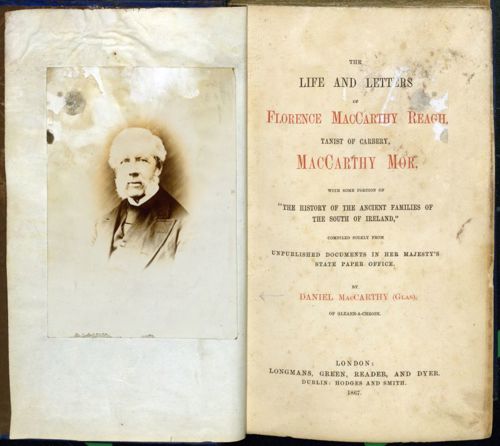
The Life and Letters of Florence MacCarthy Reagh by Daniel MacCarthy (Glas), published in 1867.
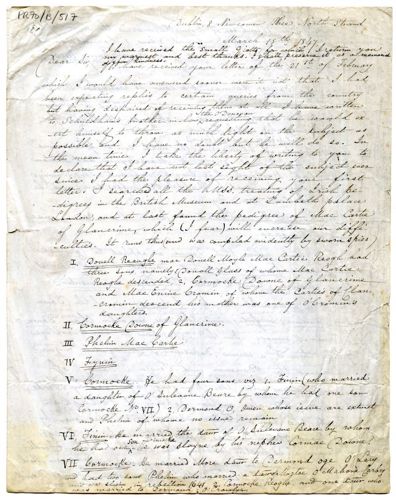
The MacCarthy Glas archive comprises 1700 unique items, and it is of major historical importance, containing personal letters, manuscripts, photographs and drawings from Daniel and other family members. Some of Daniel’s family were poets and writers, and some held important positions, reflecting the fact that they intermarried with the British élite. His father-in-law, for example, was Rear-Admiral Sir Home Riggs Popham who served in the French Revolutionary and Napoleonic Wars and invented a code of signals adopted by the Royal Navy in 1803. Also within are various manuscripts relating to Daniel’s historical and literary research and publications. The majority of the material dates from the 1700s and 1800s. As with any large personal or family archive, the scope of the collection is immense, documenting a range of topics: from the MacCarthy aristocratic lineage, to 19th century poetry and historiography, the Irish nationalist movement, the history of Early Modern Ireland, the French Revolution of 1848, the British Empire in India and South Africa, emigration, and the Great Famine and its dire impact on the local population in west Cork.
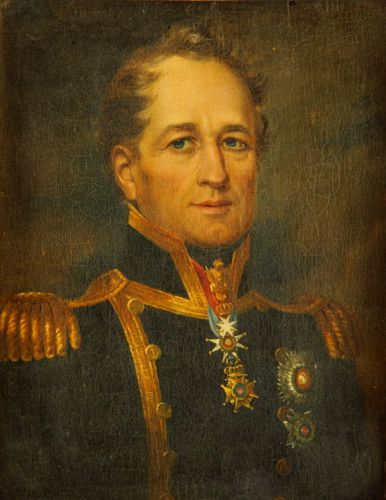
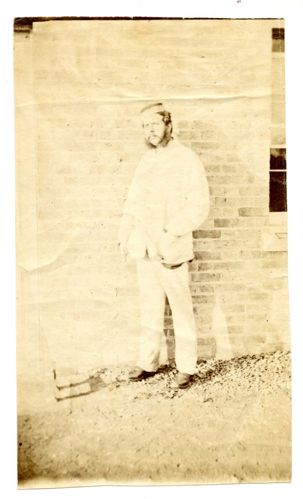
![Photograph of Alice MacCarthy [née Linton] and two of her daughters.](/media/11fl0234/pr70-f-6-2-3_web.jpg?rmode=max&height=500)
The Glas archive was painstakingly listed, arranged and catalogued in detail by the archivists of the Cork City and County Archives Service. Thanks to this, and the kind generosity of Susan and Don MacCarthy and family, the archive is now a permanent public resource for Cork. (The Archives created an exhibition about Daniel and his archive which will be on display at the Archives and at other locations around Cork. The exhibition was in part made possible through Heritage Council of Ireland funding.)
One document in the archive has been identified as having immense cultural and historical significance: this is a 1784 family pedigree of the Gaelic prince Jeremiah MacCarthy (‘Diarmuid an Duna’) compiled by famous poet-schoolmaster John Collins of Myross, known as the last bard of Munster, who, it is said, could recite much of the ancient history and genealogies of the region. This unique document, written in a combination of both Irish and English, is one of very few original manuscripts that we know of in existence from Collins or indeed any other Gaelic scholar from the period. Written on parchment, the pedigree bears a wax seal of John Butler, Catholic Bishop of Cork, later Baron Dunboyne, who was a controversial figure. The pedigree has been subject to a detailed process of transcription and interpretation by Dr. Cornelius Buttimer formerly of UCC.
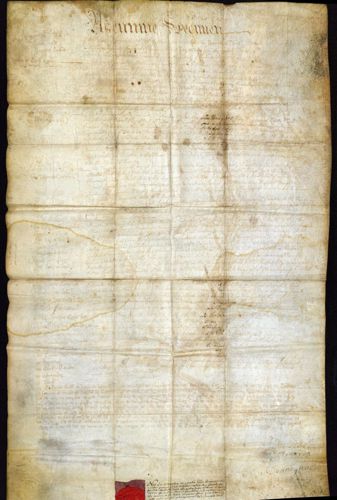
View descriptive list of the Daniel MacCarthy (Glas) Collection.

